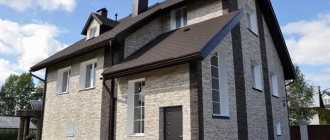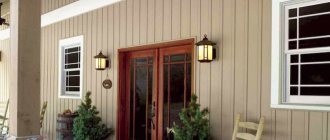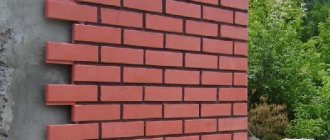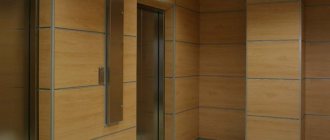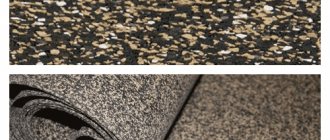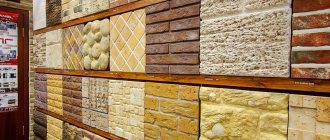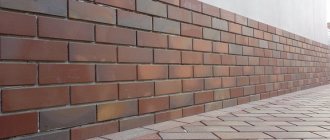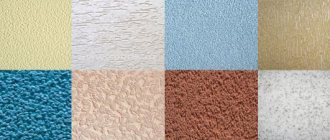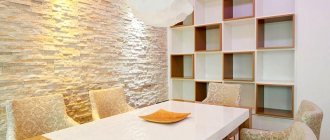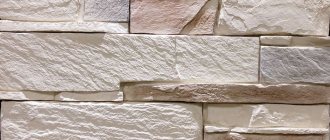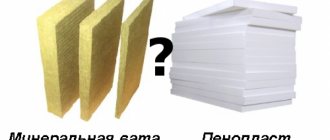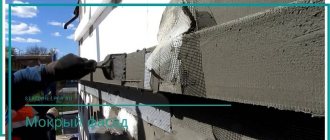Cladding the facade of a house with natural stone is a method of decorating the walls of a country house that has become widespread in modern Russia. Among the reasons that led to the popularity of this type of finishing of country houses and buildings, one can highlight the variety of materials used, which ensures the ability to solve problems in almost any color scheme and shape, and the originality of appearance, which gives individuality to each building.
Natural, otherwise called wild stone, is a natural facing material valued for its durability and strength, and a façade finished with it looks stylish and noble, which adds to the attractiveness of the building.
Properties of natural stones.
Natural facing stone used in the exterior decoration of buildings is characterized by strength, practicality and reliability, which is expressed in its resistance to such environmental conditions as exposure to high and low temperatures and their changes, high humidity, and mechanical damage.
By insulating the surface of the base of the wall, the stone extends the life of the entire building, it contributes to sound absorption and thermal insulation of the building; An important property of this type of coating, which is relevant for buildings in countryside villages vulnerable to fires, is its ability to prevent the spread of open fire.
Which material is better to choose: natural or artificial?
When choosing a stone cladding, you should take into account important factors: price and quality. The facade covering has a certain weight: the load of the cladding must be taken into account.
At a price, artificial material is more attractive. Some types of non-natural stone are in no way inferior in strength and wear resistance to natural stone . In this case, there is no need to overpay.
The wear resistance and durability of natural stone is greater. Environmental conditions must be mercilessly aggressive to damage or render natural stone unpresentable. Most often, natural cladding is chosen in urban environments, where increased gas pollution prevails and the tendency to mechanical damage is quite high.
If stone cladding is required for a private country house or building located far from the city, then it is advisable to choose artificial stone: it will last at least 50 years if installed correctly and will create a decorative look . And if you combine stone with other materials, the structure will differ favorably from neighboring houses.
Advantages and disadvantages of using natural stone for facade cladding
The above properties of natural facing stone are among its advantages; however, like any other material, the stone is also endowed with significant disadvantages that should be taken into account when choosing the final finishing option. Among the disadvantages of stone when decorating the façade of a country house are:
- weight of the structure. The density of the stone is quite high, and the weight of the wall lined with it increases very significantly, which leads to high demands on the stability of the walls;
- possible contamination of the material. Stone extraction is often carried out in places where the ecological situation leaves much to be desired, which does not exclude the possibility of obtaining a wall contaminated with radiation as a result;
- the complexity of installation makes it difficult to do the work yourself and requires the involvement of specialists in finishing the facade, which, in turn, increases the cost of finishing.
Ronson House ventilated facade system for low-rise housing construction
1 - wall; 2 - vertical profile NE; 3 — insulation with hydro-windproof film; 4 - Ronson template for installing facing stone or clinker tiles; 5 — horizontal profile of the PFC; 6 — façade bracket with thermal-breaking paronite PP1 gasket, if necessary with an extension slider POK-S; 7 — decorative facing stone White Hills. Visualization: Igor Smiryagin/Burda Media
Installation of a ventilated facade with facing stone
| Advantages | Flaws |
| Simple installation of elements without the use of wet processes. | Limited range of stone colors and textures. |
| Light weight of the ventilation façade structure, no need for additional strengthening of the foundation. | It is impossible to veneer curved planes. |
| Used for walls made of different materials and designs. | High cost of construction and work. |
| Possibility of access to communications located under the cladding. | |
| Possibility to carry out facing work all year round. |
Types of facade stone
Traditionally, the following types of finishing stone are distinguished:
- granite;
- marble;
- limestone;
- sandstone;
- slate.
Granite
This stone, which is a rock of igneous origin, is rightfully considered the most durable stone among others used in construction and decoration. A distinctive feature that distinguishes granite from other natural facing stones is its granular-crystalline structure, which underlies the division of stone into fine-, medium- and coarse-grained.
The noble colors of the granite surface, strength, and abrasion resistance that characterize it are, without a doubt, an argument in favor of purchasing this particular stone when decorating the facade. It is worth noting that the wide range of stone surfaces currently on the market (sawed, chipped, polished, heat-treated), and the variety of their shapes can satisfy the needs of the most demanding customers.
At the same time, the heaviness of this material, which significantly complicates and increases the cost of the installation process, casts doubt on the possibility of widespread use of granite. Disadvantages of stone also include instability to high temperatures, relatively rapid crumbling and cracking during fires. Granite comes in a variety of colors; there are rocks of grey, pink, red, orange, bluish-gray and bluish-green.
Marble
This stone is distinguished by such properties as strength, strength, good susceptibility to processing, and excellent appearance. It is hardly possible to dispute the statement that the surface of polished marble provides aesthetic pleasure, pleasing the viewer's eye. In its pure form, marble usually has a uniform color of light tones; impurities of other minerals color the stone green, red, and sometimes black.
A special feature of marble is the presence of veins that form a complex pattern. The disadvantage of marble is that it is difficult to use, capricious, and in danger of losing its appearance due to unfavorable external conditions. The use of marble for exterior decoration is not excluded, but traditionally this stone is still used in interior spaces that are less susceptible to temperature changes and other environmental influences.
Limestone and sandstone
These materials are very similar in appearance; often only a specialist can distinguish them. What they have in common is their origin (they belong to sedimentary rocks) and composition, as well as their relatively low weight. If sandstone consists of quartz and calcium carbonate - calcite, then limestone contains mostly calcite.
Each of these species is divided into varieties depending on appearance and physical properties.
Sandstone, which is siliceous sand grains combined through mineral binding agents, as well as feldspar or mica, varies in strength depending on the underlying mineral. Further, the properties of sandstone, which cannot be polished, determine the division of the stone according to its texture. In accordance with this criterion, such types of sandstone are distinguished as sawn, representing sawn strips of the formation, torn, differing both in shape and surface size and in thickness, and rubble: large stones of rough shape obtained as a result of rock explosion.
The most common sandstone is light shades, but it is possible to use darker saturated shades up to black. The scope of application of sandstone when carrying out exterior work is cladding the plinths and walls of buildings, columns.
Limestone: a stone of natural origin, consisting of organic remains, is classified depending on the structure as dense, consisting of lime spar and remains of fossil shells, porous, the most famous representatives of which are travertine, calcareous tuff, decorative shell rock, marble, similar in its density and composition with marble, as well as the well-known chalk.
The susceptibility of limestone to processing underlies another division into groups. Thus, there are strong limestones that can be polished and give a mirror-like shine, medium-strength limestones, the surface of which is less amenable to processing and thereby prevents the achievement of a mirror-like shine, and low-strength limestones, the structure of which excludes polishing.
In architecture, limestone is used for the external cladding of building walls. An unusual property of limestone is its bactericidal ability - its ability to purify the air from pathogenic microorganisms. The color palette is represented by white, yellowish, light gray or pink shades; stone with contrasting veins on a light background is especially appreciated.
Slate
This layered, fine-grained stone, consisting of quartz, clay and sedimentary rocks, is easy to process; its characteristic feature is the ability to split into thin plates. Good water resistance, strength, frost and heat resistance, high thermal insulation, excellent tolerance to mechanical stress that prevents destruction during processing are the undeniable advantages of this type of stone, making it indispensable for finishing the facade of a country house.
Laying technology: step-by-step instructions
The mentioned features of facing stone indicate the need to carry out work using proven technology using a large number of tools. To install stone, you need measuring tools, levels, devices for applying glue to the surface of the wall and stone, a container for cement, a drill or construction mixer necessary for mixing the cement mixture, a grinder for cutting stone, and a rubber hammer. You also need to purchase glue.
Selection of adhesive materials for natural stone surfaces
Determined by a combination of factors. First of all, it is necessary to take into account the operating conditions of the building, especially the temperature regime. The use of universal compositions by specialists is not recommended due to the fact that these compositions are not able to fully satisfy the requirements of the standards, especially in terms of moisture resistance and frost resistance.
The manufacturer also matters: it is advisable to give preference to companies located in similar climatic conditions. Another important indicator due to the large weight of the stone is high adhesion of the glue. The ability to compensate for changes in stone size due to temperature fluctuations is also one of the parameters that must be taken into account when choosing an adhesive.
Currently, there are two large groups of adhesives on the market for installing natural stone facades: cement-based and epoxy- and polyurethane-based. Cement-based adhesive meets building codes and is inexpensive. Disadvantages include low plasticity, which causes the appearance of microcracks during temperature changes and subsequent destruction of the masonry.
Epoxy resin adhesive is much more expensive than cement adhesive, but it has a number of advantages over it. Thus, the composition is more plastic, which allows it to compensate for changes in the size of the stone, prevent the appearance of microcracks and suppress the germination of moss in the seams.
Base
Before installing natural stone on the facade of a building, it must be installed when the walls were erected. This is important because building codes prohibit the finishing of a solid stone apron on a wall constructed less than six months before the planned start of work. In addition, measuring the stress of the wall masonry will help you avoid troubles in the future; here, an indicator of 0.5 MPa is critical[.
If the specified conditions are met, you can proceed to cladding the facade of the house with natural stone. The first step towards cladding the facade of a building is preparing the load-bearing surface. The specific content of these actions depends on the material of the facade. Installation of natural stone on a non-wooden surface is impossible, therefore, before cladding, a wall made of this material must be treated with a water-repellent compound, then a reinforcing wall must be fixed to it.
The preparation of a metal surface takes place in several stages: first the wall is primed, then a reinforcing mesh is attached to the ground, then the resulting base is plastered. A concrete wall is prepared for facing with stone by leveling the surface, removing protruding elements and removing dust and foreign particles.
Installation of a facade made of natural stone
This type of work is carried out on a prepared, dried surface using a ready-made adhesive mixture; in addition to the glue, it is advisable to have grout for steps available: it can be used to seal the seams immediately after laying the stone.
During the laying process, glue is applied to the surface of the wall or stone, then a relief is created on the applied mixture using a special tool called a comb, which ensures better adhesion, then the stone is pressed tightly to the selected place and tapped with a rubber mallet, excess glue is removed with a spatula. After laying the row, the tile joints are filled with grout, the excess of which is also removed with a spatula.
Finishing work
These works involve the implementation of actions aimed at giving a finished look to the facade. As a rule, they consist of filling the seams, if this work was not performed directly during the masonry process, and treating the surface with special materials that prevent the negative effects of precipitation.
Options for laying natural stone in the design of facades of country houses
All options for natural stone masonry used in the design of facades (block masonry, “Plateau”, “Castle”, “Shahriar”, “Assol”, “Rondo”) are determined by the type and shape of the stone used for wall cladding:
- The first of the mentioned methods can be called the simplest for installing natural stone; it requires the presence of stone tiles of various sizes and configurations, mounted in any order;
- “Castle” (“Castle” translated from English) imitates the wall of a knight’s castle, and therefore for cladding they require rectangular slabs of approximately the same size; sandstone, limestone and slate are usually used, but the use of granite and marble is also possible;
- the “Plateau” facade, made from the same types of stone as the “Castle”, but consisting of an alternation of rectangular and square stones, does not pretend to be natural masonry; window and door openings are usually framed in this way;
- “Shakhriar”, similar in appearance to a brick wall, is quite simple to work with; when laying out using this method, the so-called rusticated stone (rough bars) of various origins is used;
- “Assol” masonry, which represents the illusion of a cut of a rocky ledge, is made of longitudinal dies of sandstone or limestone;
- In the “Rondo” masonry, a marine theme is expressed; when decorating a country house using it, sea pebbles of various shapes are used.
Price of facing stone and installation work
Being a very popular product on the market of construction and finishing materials, natural stone has a fairly high cost. The price range is very significant, it is determined by the specific type of stone: as already mentioned, granite and marble are much more expensive than sandstone, limestone and slate.
The origin of the stone is important, but it should be noted that even the material that is mined in domestic quarries is not cheap, the price for it starts at 600-700 rubles per square meter. The cost of installing a stone facade is determined depending on the planned volume of work, but the lower limit is usually 900-1000 rubles per square meter.
It is worth noting that the relatively high cost of natural stone and the work on its installation has led to the spread of an alternative decorative material used in finishing the facade of a building - bark beetle plaster.
Possessing the attractiveness of natural stone, plaster made on the basis of cement and marble chips is not so demanding in preparing wall surfaces; it is characterized by good adhesion, high strength and resistance to mechanical stress. The disadvantages of this material include the surface texture, which makes it difficult to wash the walls covered with it.
FASTENING PARTS FOR CONNECTING cladding elements TOGETHER
Elements of external and internal cladding are connected to each other and to the wall with metal pins, staples, clamps, and fasteners. All of them must be protected from corrosion. To do this, steel elements are pre-coated with a layer of zinc or aluminum. It is prohibited to bend the fasteners after applying the anti-corrosion coating. Some structures use fasteners made of stainless steel, non-ferrous metals and alloys (copper, bronze, brass).
Adjacent elements of the external and internal cladding are connected end-to-end, stepped and wedge-shaped. When connecting end-to-end, the stones are in contact with their end faces; for slab thicknesses up to 150 mm, steel pins and staples can be used to eliminate relative displacements. Pins (pyrons) are made of round steel with a diameter of 3-8 mm and a length of 30-60 mm and are used in horizontal and vertical seams. The pins are inserted into sockets drilled in adjacent cladding elements to half their length. Staples are made of round or strip metal. They are placed in horizontal or vertical joints perpendicular to the plane of the slabs. In order not to increase the thickness of the seam, grooves are cut in the slabs and staples are inserted into them.
Fasteners for connecting stones to the wall. The cladding is connected to the wall with metal anchors and fasteners, which are simple and combined hooks, pins, staples, etc. A simple hook is made of round stainless steel with one curved end. The dimensions of the hook depend on the size of the cladding element. The hooks are installed in horizontal rows, two pieces per slab. The depth of installation of hooks into the wall must be at least 100 mm.
Combined hooks are made of stainless steel and are used to simultaneously connect cladding elements to each other and to the wall. In each horizontal row, two of them are installed in a slab. For fastening marble, dolomite, limestone slabs, mainly brass, copper, copper-plated anchors or stainless steel anchors are used.
To reduce the load and protect the supporting row from deformation during wall shrinkage, it is recommended to cladding multi-storey buildings in tiers. The unloading support row can be installed on the structural elements of the wall being lined and separated from the underlying tier by an expansion joint 5-15 mm wide. In claddings that are installed on a finished wall, the unloading row is supported on steel elements made of angle steel, fixed in the load-bearing wall. If the seam is left open at this joint, it is filled with sealant. For individual stone structures, fastenings are specially designed.
